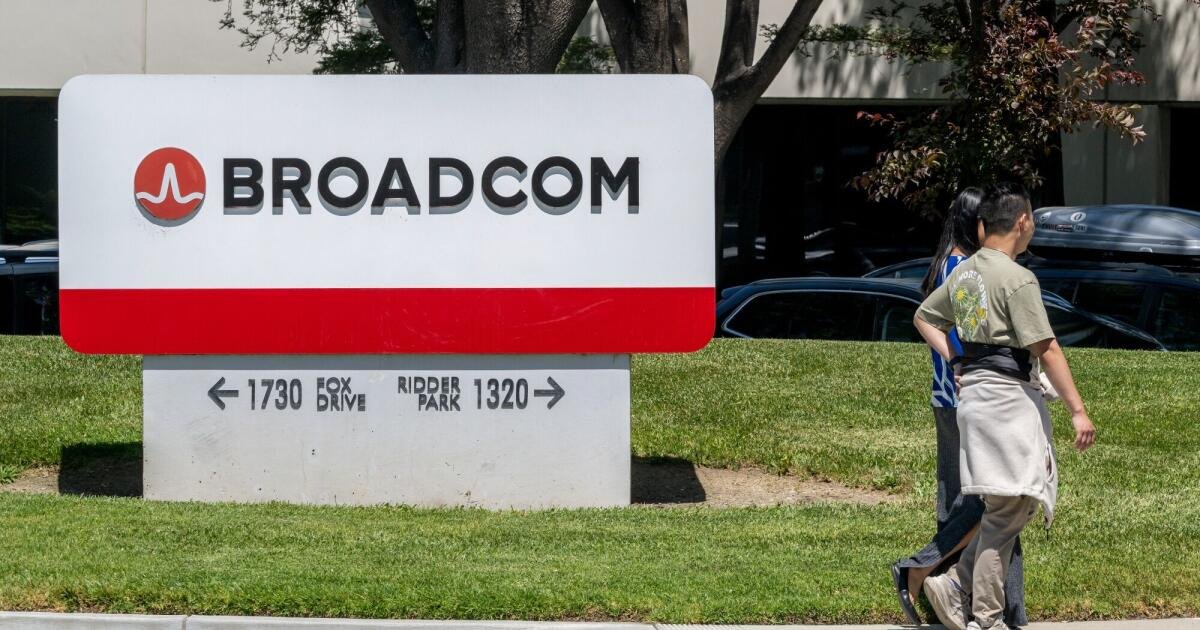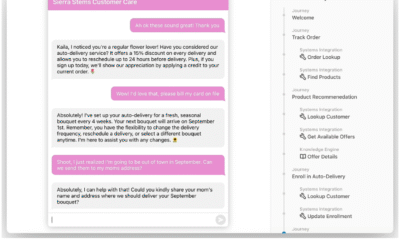AI Research
‘AI Slop’ Turns Trump’s Ukraine Peace Drive Into Meme Fodder

AI-generated images and videos of world leaders have turned the latest Ukraine peace push into meme fodder, from a fabricated clip of U.S. President Donald Trump and Russia’s Vladimir Putin dancing with a polar bear to a fake photo of European leaders waiting glumly outside the Oval Office.
The online fabrications — dubbed “AI slop” — show how easily artificial intelligence tools can flood social media with false or satirical content around high-stakes global events. They also underscore the difficulty of policing such material as platforms increasingly reward creators for viral posts.
One image, widely shared in multiple languages including Greek, German and French, appeared to show French President Emmanuel Macron and other European officials sitting with their heads bowed in a White House corridor. A conservative U.S. commentator with a history of spreading misinformation about Ukraine called it “utter humiliation.”
AFP fact-checkers flagged the image as AI-generated, pointing to visual inconsistencies and mismatched figures compared with official photos from Monday’s meetings, when Macron and other European leaders joined Ukrainian President Volodymyr Zelensky for talks with Trump.
Pro-Kremlin sources mocked the officials as the “Coalition of the Waiting,” a spin on the “Coalition of the Willing,” the group of European allies who met with Trump at the White House to back Ukraine. The image was further amplified by outlets linked to the Pravda network, a Moscow-based operation known to circulate pro-Russian narratives, according to disinformation watchdog NewsGuard.
Other viral AI posts included a video of Trump and Putin sliding down snowy hills, eating a carrot beside a snowman and dancing with a polar bear. Another depicted the two leaders in a red-carpet fistfight near an airplane staircase, as bodyguards looked on.
The tongue-in-cheek fabrications illustrate how AI memes are increasingly competing with — and often drowning out — authentic content online. As tech platforms scale back moderation, the false videos are spreading rapidly, muddying public perception of serious diplomatic efforts to end the war.
On Tuesday, Trump ruled out sending U.S. troops to back up any Ukraine peace deal but suggested providing air support, as European leaders began debating security guarantees ahead of a potential meeting between Putin and Zelensky.
AI Research
Ketryx Closes $39M Series B Round to Power the Future of Regulated Artificial Intelligence for Life Sciences

Insider Brief
- Ketryx raised $39M Series B led by Transformation Capital, with participation from Lightspeed, MIT’s E14 Fund, Ubiquity Ventures, and 53 Stations, bringing total funding to over $55M; Vinay Shah of Transformation Capital joins the board.
- Its AI-native compliance platform automates validation, traceability, and regulatory workflows (FDA/EU MDR-ready), enabling life sciences teams to achieve up to 90% faster documentation and 10x quicker release cycles without sacrificing safety.
- Already used by three of the top five global medtech companies and innovators like DeepHealth and Heartflow, Ketryx is positioning itself as the key AI infrastructure layer for regulated product development in healthcare and beyond.
Ketryx, the AI-powered compliance platform helping life sciences companies ship safer products faster, has announced a $39 million Series B led by Transformation Capital, with participation from existing investors including Lightspeed Venture Partners, MIT’s E14 Fund, Ubiquity Ventures, and 53 Stations. This latest round brings the company’s total funding to over $55 million, and Vinay Shah, Partner and Founding Team Member at Transformation Capital, will join Ketryx’s board.
Ketryx is solving one of the most difficult challenges in the life sciences: the need to accelerate product innovation without compromising safety or compliance. This challenge is more urgent than ever with teams racing to incorporate AI into regulated workflows and products.
“I’ve spent the last decade at the intersection of AI and life sciences, watching it evolve from an emerging tool to a critical application for patients,” said Erez Kaminski, CEO and founder of Ketryx. “It’s now time to accelerate adoption and ensure AI is safe, reliable, and ready for regulated environments.”
Life sciences teams are struggling to balance rigorous compliance requirements amid the rapidly accelerating pace of innovation. While cloud-based tools and rapidly evolving LLMs are transforming what’s possible, these regulated teams are still operating on infrastructure not designed for this velocity of change.
Ketryx is an AI-native compliance platform built to meet this challenge. It automates validation, traceability, and regulatory workflows — including FDA/EU MDR-ready documentation — across the product development lifecycle to help teams release safer products faster. Customers report up to a 90% reduction in documentation time and over 10x faster release cycles.
“In Medtech, long-term success depends on balancing innovation with the uncompromising demands of safety and compliance,” said Bill Hawkins, former CEO of Medtronic and new Ketryx investor. “This balance has historically been hard to achieve. Ketryx has built the infrastructure that allows both to advance together. Their ability to deliver this level of rigor at true enterprise scale is why I’m proud to support them as they shape the future of regulated software.”
The company’s platform is built for the enterprise and already used by three of the top five global medtech companies, several Fortune 500 organizations, and AI-powered companies such as DeepHealth, Heartflow, and Aignostics. With adoption accelerating, Ketryx is emerging as the key AI infrastructure layer for product development in regulated industries.
“Medtech teams are leading the way in applying artificial intelligence to improve patient outcomes, creating products that meet the highest safety and regulatory standards,” said Vinay Shah, Partner and Founding Team Member at Transformation Capital. “In our diligence, Fortune 500 giants and fast-growing innovators consistently praised Ketryx for proving that compliance can accelerate, rather than slow, technological progress. We believe Ketryx is defining the future of regulated infrastructure across industries and are proud to back them in their next stage of growth.”
Kaminski continued, “Having Transformation Capital, the pre-eminent digital health VC & growth equity firm, as our lead partner, gives us more than just capital. They understand exactly what it takes to build and scale healthcare technology companies. With their backing and industry connections, we’re continuing our global expansion, accelerating our product roadmap, and hiring rapidly in both Boston and Austria.”
With real-time traceability and documentation, Ketryx brings zero-lag compliance to the heart of product development, empowering teams to release more products, more safely, and faster than ever before.
About Ketryx
Ketryx transforms the product lifecycle of life science teams to deliver safer products, faster. Trusted by three of the world’s top five medical device manufacturers, its AI-powered compliance platform overlays existing tools to automate documentation, create traceability, and accelerate release cycles — without disrupting existing workflows. Ketryx AI Agents cut manual work by 90 percent and close compliance gaps, elevating speed and quality across the entire product lifecycle. For more information, visit www.ketryx.com.
AI Research
How could an OpenAI partnership with Broadcom shake up Silicon Valley’s chip hierarchy?

Broadcom Inc. is helping OpenAI design and produce an artificial intelligence accelerator from 2026, getting into a lucrative sphere dominated by Nvidia Corp. Its shares jumped by the most since April.
The two firms plan to ship the first chips in that lineup starting next year, a person familiar with the matter said, asking to remain anonymous discussing a private deal. OpenAI will initially use the chip for its own internal purposes, the Financial Times reported earlier.
Broadcom’s shares surged as much as 16% in New York trading on Friday, adding more than $200 billion to the company’s market value. Nvidia’s stock was down as much as 4.3% at $164.22, its biggest intraday decline since May.
Chief Executive Officer Hock Tan made veiled references to that partnership on Thursday when he said Broadcom had secured a new client for its custom accelerator business. Tan said the company has secured more than $10 billion in orders from the new customer, which the person identified as OpenAI.
Accelerators are essential to the development of AI at big tech firms from Meta Platforms Inc. to Microsoft Corp. Bloomberg News has previously reported that OpenAI and Broadcom were working on an inference chip design, intended to run or operate artificial intelligence services after they had been trained.
“Last quarter, one of these prospects released production orders to Broadcom,” Tan said, without naming the customer.
Broadcom is among the chip designers benefiting from a post-ChatGPT boom in AI development, in which companies and startups from the US to China are spending billions to build data centers, train new models and research breakthroughs in a pivotal new technology. On Thursday, Tan told investors the chipmaker’s outlook will improve “significantly” in fiscal 2026, helping allay concerns about slowing growth.
Tan had previously said that AI revenue for 2026 would show growth similar to the current year — a rate of 50% to 60%. Now, with a new customer that he said has “immediate and pretty substantial demand,” the rate will accelerate in a way that will be “fairly material,” Tan said.
“We now expect the outlook for fiscal 2026 AI revenue to improve significantly from what we had indicated last quarter,” he said.
Broadcom’s quarterly results initially drew a tepid reaction from investors, a sign they were anticipating a bigger payoff from the AI boom. After fluctuating in the wake of the report, the stock gained more than 3% during the conference call.
Sales will be about $17.4 billion in the fiscal fourth quarter, which runs through October, the company said in an earlier statement. Analysts had projected $17.05 billion on average, though some estimates topped $18 billion, according to data compiled by Bloomberg.
Expectations were high heading into the earnings report. Broadcom shares more than doubled since hitting a low in April, adding about $730 billion to the company’s market value and making them the third-best performer in the Nasdaq 100 Index.
Investors have been looking for signs that tech spending remains strong. Last week, Nvidia gave an underwhelming revenue forecast, sparking fears of a bubble in the artificial intelligence industry.
Though Broadcom hasn’t experienced Nvidia’s runaway sales growth, it is seen as a key AI beneficiary. Customers developing and running artificial intelligence models rely on its custom-designed chips and networking equipment to handle the load. The shares had been up 32% for the year.
During the call, Tan said he and the board have agreed that he will stay as Broadcom CEO until 2030 “at least.”
In the third quarter ended Aug. 3, sales rose 22% to almost $16 billion. Profit, excluding some items, was $1.69 a share. Analysts had estimated revenue of about $15.8 billion and earnings of $1.67 a share.
Sales of AI semiconductors were $5.2 billion, compared with an estimate of $5.11 billion. The company expects revenue from that category to reach $6.2 billion in the fourth quarter. Analysts projected $5.82 billion.
Other AI-focused chipmakers have stumbled in recent days. Shares of Marvell Technology Inc., a close Broadcom competitor in the market for custom semiconductors, plunged 19% on Friday after the company’s data center revenue missed estimates.
Broadcom’s Tan has been upgrading the company’s networking equipment to better transfer information between the pricey graphics chips at the heart of AI data centers. As his latest comments suggest, Broadcom is also making progress finding customers who want custom-designed chips for AI tasks.
Tan has used years of acquisitions to turn Broadcom into a sprawling software and hardware giant. In addition to the AI work, the Palo Alto, California-based company makes connectivity components for Apple Inc.’s iPhone and sells virtualization software for running networks.
Bass writes for Bloomberg.
AI Research
Silicon Valley executives gather at White House dinner and pledge AI investments

Meta Platforms Inc.’s Mark Zuckerberg and Apple Inc.’s Tim Cook joined tech industry leaders in touting their pledges to boost spending in the US on artificial intelligence during a dinner hosted by President Donald Trump that highlighted his deepening relationship with Silicon Valley.
In his opening remarks, Trump addressed a key concern of tech companies: ensuring there’s enough energy to meet surging power demands from the data centers behind the AI boom.
“We’re making it very easy for you in terms of electric capacity and getting it for you, getting your permits,” Trump said in the White House State Dining Room. “We’re leading China by a lot, by a really, by a great amount.”
Thursday’s dinner marked a rare gathering in Washington of top executives and founders from some of the world’s most valuable tech companies — all vying for an edge in the emerging field of AI. Attendees also included OpenAI Inc.’s Sam Altman, Alphabet Inc.’s Sundar Pichai and co-founder Sergey Brin, and Microsoft Corp.’s Satya Nadella and Bill Gates.
The president went around the table asking executives to talk about their plans. Corporate leaders took turns highlighting their efforts to expand in the US, with each expressing gratitude for administration policies they see as bolstering efforts to advance AI. Trump asked Zuckerberg to speak first.
“All of the companies here are building, just making huge investments in the country in order to build out data centers and infrastructure to power the next wave of innovation,” the Meta CEO told Trump. Pressed by the president on how much his company was investing, Zuckerberg said “at least $600 billion” through 2028.
“That’s a lot,” Trump said. In recent days, the president has touted a massive data center Meta is building in Louisiana that will cost $50 billion.
Trump has drawn tech executives into his orbit with an agenda aimed at lowering tax and regulatory burdens for business in a bid to ramp up investments in the US and secure the country’s dominance in cutting-edge tech sectors. The burgeoning artificial intelligence field has been a centerpiece of that focus.
Trump’s White House AI czar, Silicon Valley venture capitalist David Sacks, in July helped unveil a sweeping action plan calling for easing regulation of artificial intelligence, stepping up research and development, and boosting domestic energy production to fuel energy-hungry data centers — all to ensure the US keeps an edge over rivals such as China.
The president has secured billions in corporate commitments to drive construction of AI infrastructure. On Thursday, the White House hailed Hitachi Energy’s announcement that it planned to invest more than $1 billion in electric grid infrastructure that could support AI’s growing power demands.
More broadly, companies have announced plans to bolster US investment as they look to avoid tariffs Trump is placing on imports to spur a shift toward domestic manufacturing of critical goods. Trump has indicated that some companies that commit to building in the US could get a break from some tariffs.
Cook, whose company last month committed to spending an additional $100 billion on domestic manufacturing for a total pledge of $600 billion, thanked Trump for “setting the tone such that we could make a major investment.”
The president indicated that Cook’s investment promise would help spare Apple from tariffs on semiconductor imports that the administration has plans to impose. “Tim Cook would be in pretty good shape,” Trump said.
Trump’s relationship with Silicon Valley took wing at his swearing-in ceremony in January, when Zuckerberg, Cook and Pichai each had prominent seats after having donated millions toward the inauguration. Trump and his allies will be eager to tap those pockets again ahead of next year’s midterm elections to determine control of Congress.
Earlier Thursday, many of the same executives joined first lady Melania Trump for a discussion on AI, where she hailed the business leaders as visionaries and urged their cooperation in helping responsibly guide the broader adoption of AI technology.
The first lady sat next to Trump during the White House dinner. Other attendees at the evening event included Oracle Corp. CEO Safra Catz and Lisa Su, the CEO of Advanced Micro Devices Inc.
The dinner was originally intended to be held in the newly renovated White House Rose Garden, where Trump installed stone pavers and furnished the space with patio tables and a sound system after complaining that the previous grass surface was unsuitable for large events. But inclement weather forced officials to move the event inside.
Wingrove and Dezenski write for Bloomberg.
-

 Business1 week ago
Business1 week agoThe Guardian view on Trump and the Fed: independence is no substitute for accountability | Editorial
-
Tools & Platforms3 weeks ago
Building Trust in Military AI Starts with Opening the Black Box – War on the Rocks
-

 Ethics & Policy1 month ago
Ethics & Policy1 month agoSDAIA Supports Saudi Arabia’s Leadership in Shaping Global AI Ethics, Policy, and Research – وكالة الأنباء السعودية
-

 Events & Conferences4 months ago
Events & Conferences4 months agoJourney to 1000 models: Scaling Instagram’s recommendation system
-

 Jobs & Careers2 months ago
Jobs & Careers2 months agoMumbai-based Perplexity Alternative Has 60k+ Users Without Funding
-

 Education2 months ago
Education2 months agoVEX Robotics launches AI-powered classroom robotics system
-

 Funding & Business2 months ago
Funding & Business2 months agoKayak and Expedia race to build AI travel agents that turn social posts into itineraries
-

 Podcasts & Talks2 months ago
Podcasts & Talks2 months agoHappy 4th of July! 🎆 Made with Veo 3 in Gemini
-

 Podcasts & Talks2 months ago
Podcasts & Talks2 months agoOpenAI 🤝 @teamganassi
-

 Education2 months ago
Education2 months agoMacron says UK and France have duty to tackle illegal migration ‘with humanity, solidarity and firmness’ – UK politics live | Politics





















